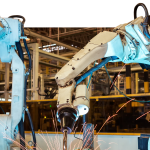UK C-levels taking command of automation programs

Just last month, the UK government warned that its country was on the backfoot with the implementation of robotics and automation compared to G7 rivals.
This month, a report from Thoughtonomy and Teknowlogy Group suggests that if the UK’s rate of adoption was indeed lagging, businesses are now taking note and are ready to ramp things up.
Sixty percent of organizations are aiming to automate at least 10 percent of all operational processes within five years, the report said.
That represents double the current level of automation. More than a third (38 percent) expect to have automated more than 20 percent of their processes within the same timeframe.
C-level stepping up
The hike in automation initiatives is owed to a growing awareness at the board-level.
While those in the organization further down the pile, whether it’s marketing, sales, IT or HR, are often aware of the need to innovate, talking management into investing is a commonly-cited hindrance to digital transformation.
However, the report suggests automation and AI are becoming a “critical and strategically imperative” for UK businesses across all sectors, and subsequently seeing greater helmsmanship from the top flight, not just the IT department.
More than half (55 percent) of CEOs are now involved in building business cases for new automation initiatives, along with 43 percent of Chief Digital Officers and 39 percent of CIOs.
In a recent interview with TechHQ, Globant’s VP of Technology for Globant’s Artificial Intelligence and Process Automation Studios, Agustin Huerta, said that automation and Robotic Process Automation (RPA) deployment was doomed to “fail” without departmental alignment, urging businesses to have central control over automation.
“I have seen many implementations fail because they are just pushed by IT,” said Huerta. “So they don’t get the buy-in of the business and they are not allowing them to review more processes that could be potentially automated.
“And the other way round too; businesses are pushing this, but IT is not convinced of the technology on the security that needs to be tackled.”
The rise of intelligent automation
At the same time, motivations behind automation are evolving as the technology becomes more advanced. In the whitepaper ‘Taking Automation to the Next Level’, the report refers to ‘intelligent automation’ as the combination of AI and machine learning, and RPA.
Whereas previous cases for automation were to deliver cost reduction (cited among 42 percent of automation strategy leaders), over the next five years advances in intelligent automation could lead to increased focus on improving productivity (44 percent), improving business outcomes (24 percent) and to increase speed to market (12 percent).
More than half (52 percent) of organizations state that creating new or enhanced revenue streams will become one of the three main targets for future initiatives.
YOU MIGHT LIKE

How wide is the RPA ‘kill zone’?
“This research indicates that many organizations are now setting their sights beyond RPA and moving quickly through the first wave of intelligent automation, where digital labor is primarily about streamlining processes and removing cost, to the second and third wave, where digital labor becomes a strategic asset to change and optimize the way that organizations run their entire operations,” said Terry Walby, CEO of Thoughtonomy.
“And what’s exciting is that with this shift, the benefits become far greater— increased productivity, more robust regulatory compliance, enhanced capacity and more fulfilling work for staff, and more agility and scalability of resources across the entire organization.
“As we have been predicting, intelligent automation will become the major catalyst for growth, innovation, and differentiation across nearly all sectors.”
A shift from the back office
Along with a shift to applying automation to more strategic objectives, there will also be a change in the types of processes on which organizations focus as they scale their programs up.
Business-critical processes will still comprise the majority (62 percent), but more businesses will also apply the technology to customer-facing, front-office processes (24 percent).
Commenting on the findings of the report, Nick Mayes, Principal Analyst at Teknowlogy Group, said the research showed that strategy leaders are “eager to accelerate their intelligent automation programs.”
He added that they “should take the time to develop a robust and future-looking strategy, with the right governance, skills, and technology platform in place, so that they can scale at speed, but in a controlled and effective way.”









